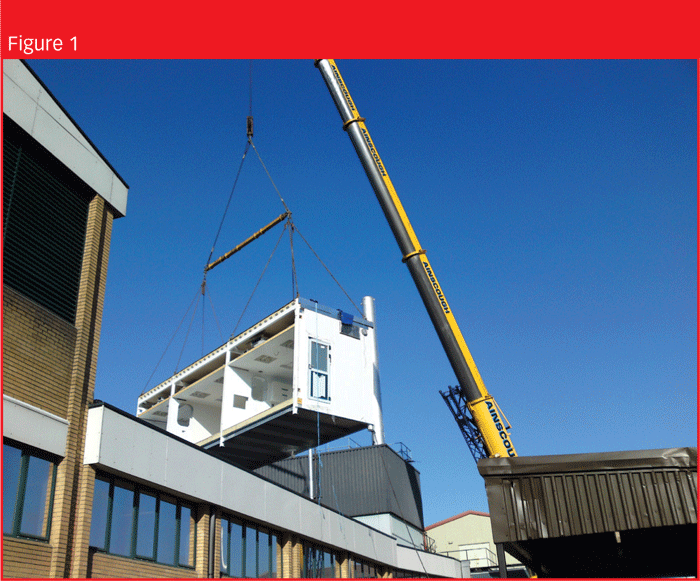Should you implement modular cleanrooms?
Modular cleanrooms are a flexible and adaptable solution that come on the back of a lorry and offer numerous benefits.
This article is part of a special feature on cleanrooms that was published in the December issue of PTE Digital, available at http://www.pharmtech.com/ptedigital1210.

Jelle Hanse. Export Executive, Clean Modules Ltd. (UK)Modular cleanrooms are a flexible and adaptable solution that come on the back of a lorry and offer numerous benefits. Modular cleanrooms can be both temporary and permanent facilities, often used to extend an existing facility, to provide a new standalone facility, or to be used as a mobile unit. When thinking of modular cleanrooms, most people think of small, temporary, containerised cleanrooms; however the modular facility will, in fact, have the same rigid feeling as a traditionally built cleanroom.
In particular, modular cleanrooms can be extremely beneficial to projects with restricted site access. As modular units are transportable, they can be lifted into any location — within enclosed courtyards, on top of another building, on a car park or an open area. This enables cleanrooms to be constructed in locations that may have been ignored when considering a more traditional cleanroom facility. Additionally, most of the construction is performed off site.

Figure 1.
Modular cleanrooms are also an effective solution when time is an issue because construction can be completed quickly. Modular facilities are fitted, commissioned and validated away from the site, and then rapidly installed and put to use. Traditionally built cleanrooms require the shell building to be completed first, but with a modular facility; however, the air handling plant is prepared off site, while the foundation and in situ cleanroom area are being completed in parallel, thus optimising construction time. Time on site costs money, especially when the construction site is in another country and crews have to be sent abroad. As such, reducing the time on site will result in cost savings. Additionally, as construction takes place off site, the client’s operations can continue without interruption.
Choosing a cleanroom
Cleanrooms come in all types, shapes and sizes, and can be used for various purposes and industries. The most common cleanroom types are the in situ, panel, flexible/softwall, modular and containerised cleanrooms, but sometimes a combination of several solutions may be more applicable. There is a lot to be considered when buying a cleanroom. You should ask the following questions:
- What you are going to use your cleanroom for?
- How long do you plan to use your cleanroom?
- Where do you want to build your cleanroom?
- How much space do you have?
- How does building this cleanroom affect your site and existing operations?
- How are you funding your cleanroom?
- How urgently do you need your cleanroom facility?
Once you know what you want and how important each criteria is, you can begin comparing different cleanroom building techniques. Cleanrooms are versatile and can be used in many different ways and situations. The most suitable solution may not always be known to the customer, but can make a difference to the effectiveness and efficiency of the cleanroom facility. There are various cleanroom solutions available to match different demands, sites and customer requirements.
Modular panel cleanrooms
This solution is based upon a composite panel system that forms the wall and ceiling structure of the cleanroom facility. This is a prefabricated and quick installation solution that can be used for retrofitting an existing area or for building a cleanroom facility within an existing open space, such as a warehouse. It is constructed on site within an existing shell building and requires site preparation before construction commences. As such, this solution is most suited for projects that will be constructed within an existing building.
Container cleanrooms
Container cleanrooms are constructed within a 20 ft (6 m) or 40 ft (12 m) container and are transported by a lorry, much like a modular cleanroom. However, they are restricted to the perimeter of the container.
This type of cleanroom is more portable than the modular cleanroom and is normally used for facilities that need to be moved frequently. This solution is also ideal for temporary short-term use.
Flexible/softwall cleanrooms
This solution is mostly used to upgrade a particular area; for example, around a certain piece of equipment, and often has a solid frame with flexible wall panels. Although it can be constructed in several sizes, it is not as rigid as a permanent structure. This can be a good solution for short-term upgrades.
Cleanroom challenges
The main challenge for a cleanrooms provider is to provide a facility that the customer is satisfied with and proud to show to others. Involving the customer (and especially the end user) is a key component of success. This can be achieved via a structured sequence of project review meetings throughout the design and implementation phases. Whilst the end user has their ‘day job’, experience shows that this process yields considerable benefits in the long run because issues are teased out in the design stage and many problems are solved before the solution is implemented.
The ultimate goal is to ensure the customer is happy with the facility and to achieve a longstanding relationship with the customer. A project is not a one-off project, but a longstanding partnership so getting it right first time is essential.
One issue that can have an impact on a customer’s long-term budget is the running cost and the environmental impact of the air handling unit. An air handling unit consumes a high volume of energy, but clever design can reduce running costs. There are various systems and set-ups available, such are recycling and piggyback air systems that will reduce the running costs. Every cleanroom facility is different, but carefully selecting the correct type of air system could save the customer a lot of money in the long run.
Pharmaceutical Tariffs Are Imminent: How Industry is Bracing for Impact
April 16th 2025On April 14, 2025, the Trump Administration launched a national security-driven investigation into pharmaceuticals, a move that will likely result in tariffs being placed on pharmaceutical drugs, ingredients, and other components that are imported from outside of the United States.
Drug Solutions Podcast: A Closer Look at mRNA in Oncology and Vaccines
April 30th 2024In this episode fo the Drug Solutions Podcast, etherna’s vice-president of Technology and Innovation, Stefaan De Koker, discusses the merits and challenges of using mRNA as the foundation for therapeutics in oncology as well as for vaccines.